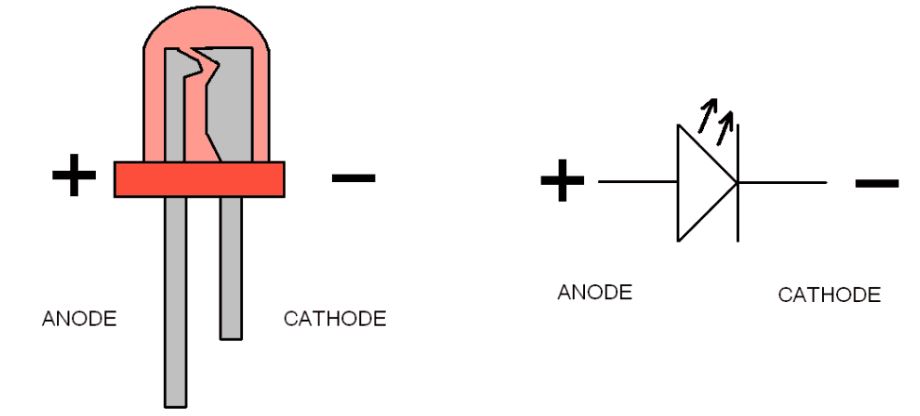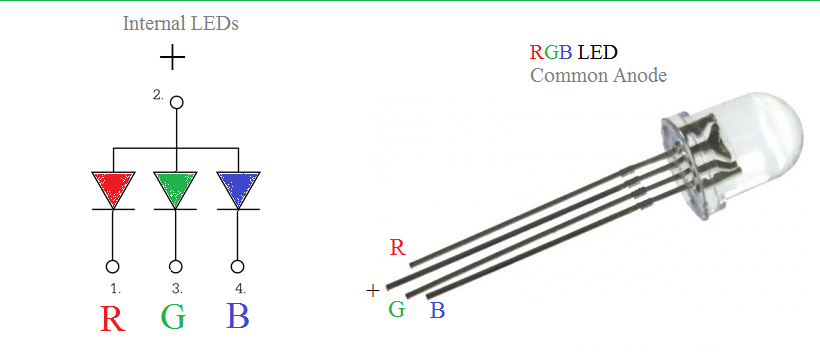LED anode cathode describes the two terminals that control how an LED works. The anode is the positive side, and the cathode is the negative side. An LED only lights when current flows from anode to cathode, so this polarity decides whether the LED glows or stays dark.
How to Identify LED Anode and Cathode?
Every LED has two sides: the anode and the cathode. The anode is the positive side. The cathode is the negative side. Without knowing which is which, the LED will not turn on. So the first step is to identify them.
For through-hole LEDs, this is easy. One leg is longer. One leg is shorter. The longer leg is the anode. The shorter leg is the cathode.
There is also a second clue. If you look inside the clear LED body, the two metal parts are not the same. One of them is bigger and shaped like a small ācup.ā This internal cup is the cathode. The smaller internal part is the anode.
For surface-mount LEDs, you will not see long legs or cups. You may see a small notch, a line, or a dot printed near the cathode. The board footprint often has a shape to guide placement as well.
Which Side Is Cathode and Anode on LED?
The rule stays the same for every LED type. The anode connects to the positive side of your power source. The cathode connects to the negative or ground.
If you hold an LED in your hand and check the legs, the longer one is always the anode. The shorter one is always the cathode.
When the LED is mounted in a circuit, the PCB often includes a silkscreen mark. A small triangle or flat edge on the LED outline usually points toward the cathode.
In RGB LEDs, the pattern may change slightly. You might find a ācommon anodeā or a ācommon cathode.ā But the idea is still the same. There is always one shared pin and three separate pins for red, green, and blue.
Do LED Lights Need Correct Polarity?
Yes. LED lights always need correct polarity. LEDs are diodes. A diode only conducts current in one direction. That means power flows from the anode to the cathode.
If you reverse the polarity, the LED will not light. It does not glow halfway. It does not flicker. It simply stays off. But in most cases, the issue is just reversed polarity.
Correct polarity keeps the LED bright, stable, and long-lasting. When you supply current in the right direction, the LED performs at its best.
How to Connect LED Cathode and Anode?
You place the anode toward the positive voltage. You place the cathode toward ground. Between the LED and the power source, you add a current-limiting resistor. This protects the LED from getting too much current.
For example, if you power a standard 5 mm LED from a 5V source, a resistor of around 220 Ī© to 330 Ī© is common. This keeps the brightness stable and extends the LEDās life.
If you place multiple LEDs in series, the polarity of each LED must line up in the same direction. All anodes face the same way. All cathodes face the same way. The flow of current becomes steady.
If the LEDs are connected in parallel, each LED still needs its own resistor. This keeps brightness even. It also prevents one LED from drawing more current than the others.
Which Leg of LED Is to Ground?
The cathode leg goes to ground. The short leg. The inner metal cup. The side marked with a flat edge on the LED housing.
Ground provides a safe return path for current. When the cathode is tied to ground, the LED behaves predictably. Your brightness level remains stable. The circuit stays safe and balanced.
When you see āGNDā or a ground symbol on a schematic, that line always connects to the LEDās cathode.
What Are the Pins of a Common Anode RGB LED?
A common anode RGB LED contains four pins:
- A shared anode
- A red cathode
- A green cathode
- A blue cathode
The shared anode connects to the positive voltage. Each individual color channel is controlled by pulling its cathode toward ground through a resistor. When you energize one channel, you get a single color. When you energize two or three, you blend colors to create new ones.
Because the shared anode handles all three diodes inside the LED, wiring stays clean. You can create calm pastels, bright neon tones, or smooth gradients. You can pulse the colors slowly. You can flash them fast.
What Happens If LED Polarity Is Wrong?
If you reverse the LED anode and cathode, the LED will not light up. This behavior protects the LED in many cases. However, in more powerful circuits, reverse polarity may stress the LED. At high voltage or high reverse current, the LED may face damage.
Most of the time, the LED simply stays dark. You correct the polarity. It lights up again.
What Are Common LED Polarity Mistakes?
These mistakes are simple. Here are the most common ones:
- 1. Cutting the LED legs too short
The longer leg marks the anode. When both legs become equal after trimming, it becomes harder to tell which is which.
- 2. Ignoring the LED flat edge
Most round LEDs have a small flat spot on the cathode side. If you overlook this sign, you may place the LED backward on the board.
- 3. Rushing during placement
When you wire many LEDs at once, small polarity mistakes stack up fast.
- 4. Mixing LED types
Through-hole LEDs and SMD LEDs use different marking systems. If you switch back and forth without checking the datasheet, you may align them the wrong way.
- 5. Misreading PCB silk marks
Some boards use a triangle, dot, or line to mark polarity. A quick double-check prevents mistakes.
If you require guidance, support, or high-quality PCB solutions for electronic products, please feel free to contact us at sales@bestpcbs.com
Tags: led anode and cathode, led anode cathode, led cathode and anode, led diode cathode anode, led light anode and cathode





